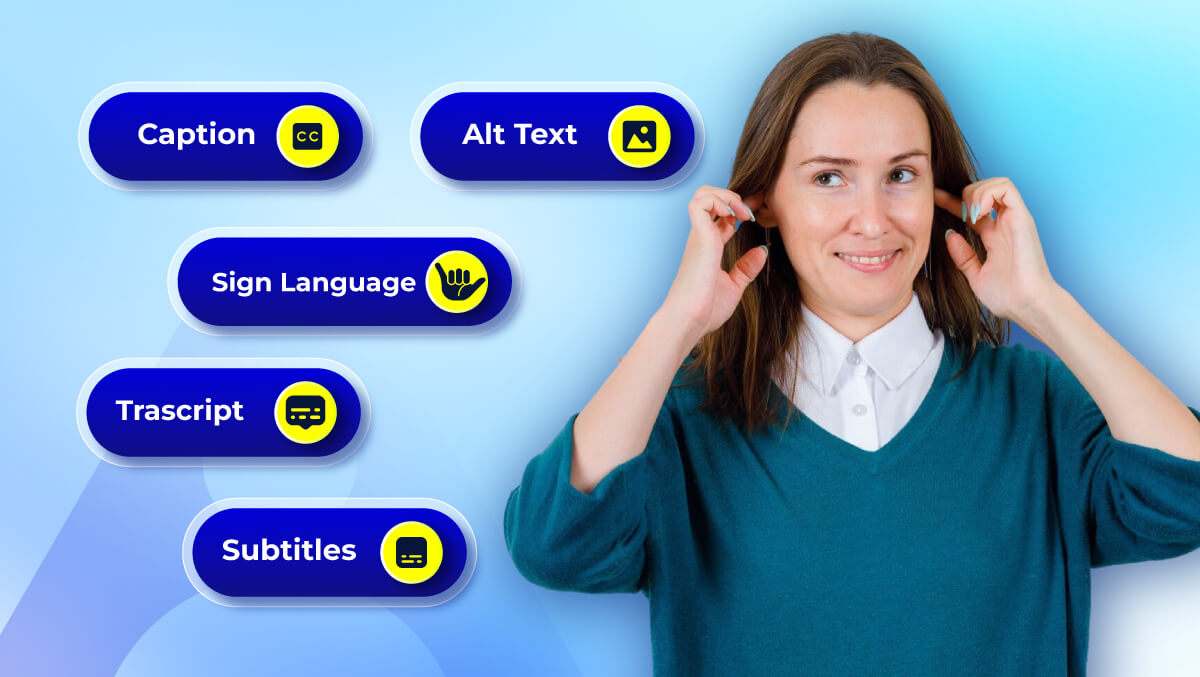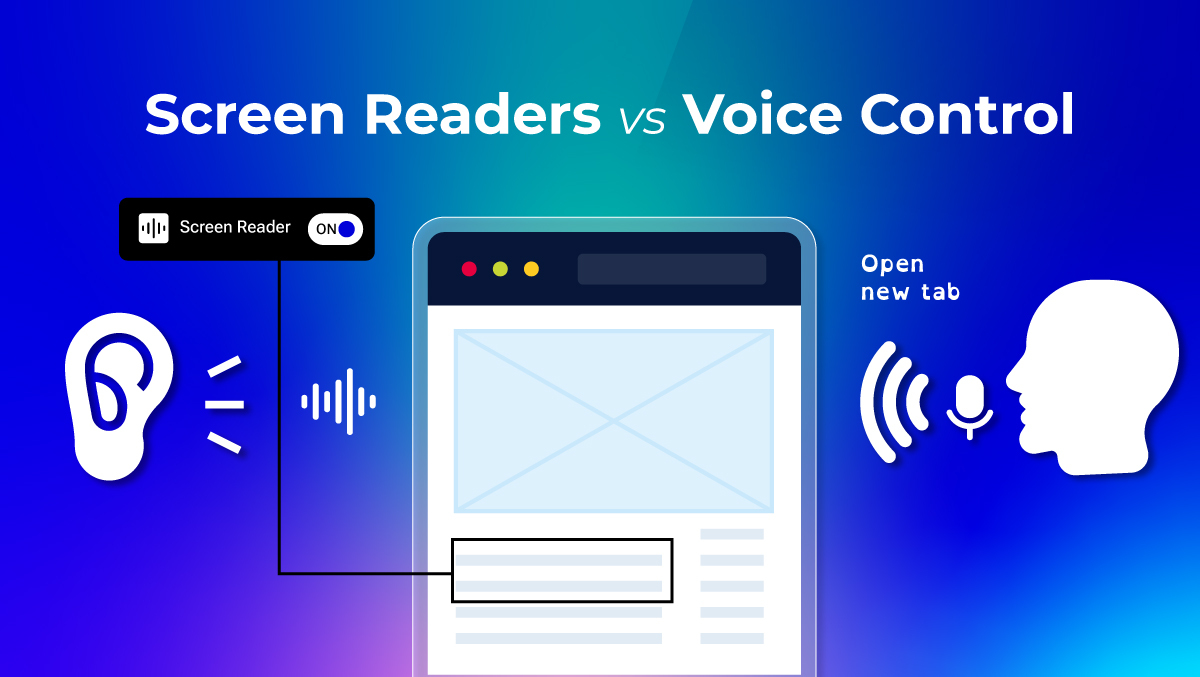Legal Risks of Ignoring Accessibility: Every Business Should Know
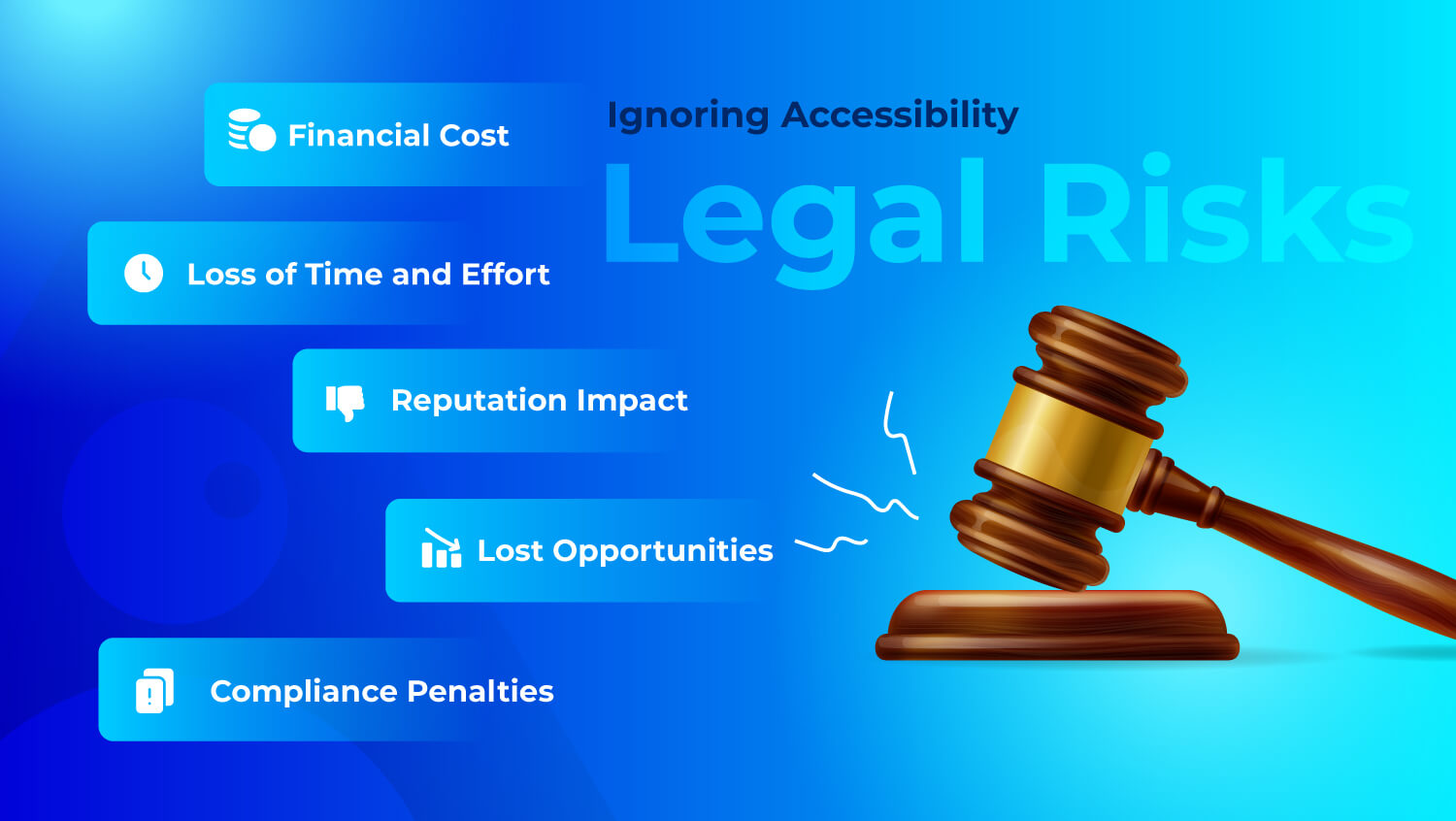
Many businesses don't actively set out to disregard accessibility; it unintentionally falls off the radar. An accelerated launch, a new capability, a design refresh. A website that used to be accessible is not.
What may look like a small gap can develop quietly into a risk to your legal standing and reputation. Globally, regulations are now mandating inclusive digital experiences, and those that don't adapt are beginning to feel the repercussions.
So here we will provide the case for understanding the legal risks of ignoring accessibility, and the straightforward and strategic steps that will keep your business intact and widely regarded.
Why Accessibility Is a Legal Obligation
All over the world, governments have underscored that digital accessibility is a basic right and not a design preference. Although it varies by region and country, some laws enforce these principles, with access being a legal requirement:
- United States: The Americans with Disabilities Act (ADA) and Section 508 require businesses and public agencies to have accessible websites for people with disabilities.
- European Union: The European Accessibility Act (EAA) requires that products and services available in the EU market be accessible.
- United Kingdom: The Equality Act 2010 protects users from discrimination and requires equal access to online products and services.
- Canada & Australia: Legislation, such as the Accessible Canada Act and the Disability Discrimination Act, establishes similar regulations for the broad diversity of online experiences.
All of these regulations apply to government agencies and apply to private companies too, from eCommerce businesses to corporate websites.
Common Legal Risks of Ignoring Accessibility
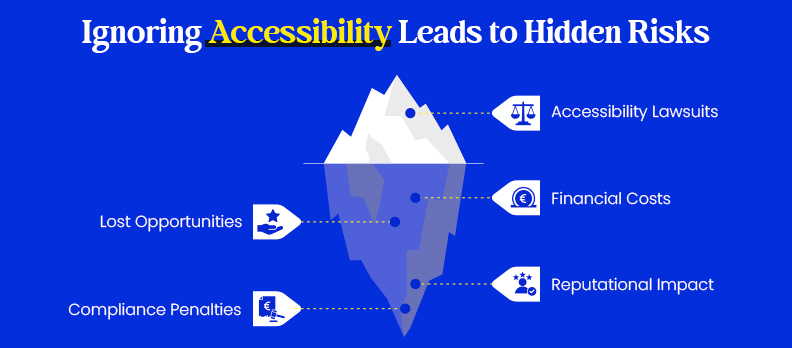
Organizations can confront varied legal, financial, and reputational struggles that may be extremely difficult to repair. Here is a list of the most common risks organizations experience:
a) ADA or Accessibility Lawsuits
In the United States, ADA-based lawsuits have been steadily increasing over the past several years. Both large and small businesses are being held responsible. It is alarming how a complaint can quickly escalate into a legal process or demand for a settlement.
b) Financial Costs
Accessibility issues after a lawsuit will always be more costly than prior to the lawsuit. The costs of attorneys, settlements, and the urgency to fix issues can handcuff budgets, especially with small organizations and mid-sized organizations.
c) Reputational Impact
Accessibility lawsuits or bad press can impact customers' and partners' views of a brand. One news article in a publication about non-compliance can destroy years of trust and goodwill, particularly in businesses where awareness or consideration for accessibility was a part of care values.
d) Lost Opportunities
An inaccessible website automatically eliminates a part of the market, customers who rely on assistive technologies. In addition to the legal aspects, this eliminates reach, sales, and engagement opportunities that become opportunities for competitors that provide accessible products or services.
e) Compliance Penalties (Region-Specific)
In some municipalities or states, accessibility standards are enforced with regulatory fines. Fines differ by municipality, but they all convey one message: accessibility is no longer negotiable.
Real-World Examples
Those were just three of the major lawsuits that demonstrated how failure in digital accessibility can lead to serious legal consequences.
1. Domino’s Pizza (U.S.)
In Robles v. Domino’s Pizza LLC, a visually impaired customer filed a lawsuit against Domino’s because their website and app were not compatible with screen readers. The judges decided that the company’s digital platforms have to be in line with ADA and WCAG standards (adasoutheast.org).
2. Winn-Dixie Stores (U.S.)
In Gil v. Winn-Dixie Stores, Inc., a customer alleged that the retailer’s website was not accessible. The very first decision found violations of the ADA, but upon appeal, the decision was reversed because the site is not a “public accommodation” by itself (news.mobar.org).
3. Fashion Nova (U.S.)
In 2024, Fashion Nova agreed to pay a $5.15 million settlement to resolve a class-action lawsuit alleging that the company's website was inaccessible to blind users (convergeaccessibility.com).
NOTE: These are just the tip of the iceberg; countless businesses in different sectors have come to terms with the same issue, which is that accessibility compliance is no longer an option, but a shared responsibility.
How Accessibility Lawsuits Typically Unfold
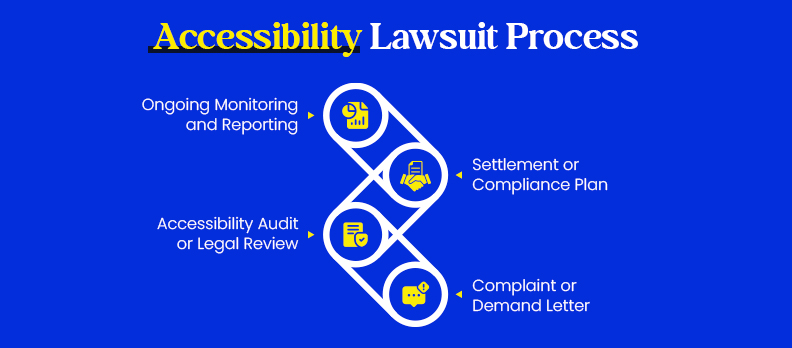
Accessibility lawsuits are often quite subtle in the beginning, with a complaint or a user’s frustration, and can escalate very fast into legal and financial problems.
1. Complaint or Demand Letter
A user or an advocacy group identifies accessibility barriers and usually reports them through a legal notice or a demand letter. In this step, it is common for the party to indicate what areas of your website, app, or digital document are inaccessible and cite laws such as ADA or WCAG standards.
2. Accessibility Audit or Legal Review
After the claim, the concerned businesses are called upon to give their views on the matter. This necessitates a formal audit (manual and automated testing) to pinpoint accessibility loopholes. Besides, the legal counsel may evaluate the situation from the point of view of risks and solutions.
3. Settlement or Compliance Plan
In case there is a non-compliance situation, companies usually strike a deal or agree to a compliance plan. It may involve making the necessary corrections to accessibility, paying a settlement amount, and giving a pledge for the regular audits or staff training.
4. Ongoing Monitoring and Reporting
Compliance is not stopped after the closing of the case. Regulators or advocacy groups may monitor the progress for the specified time. Keeping an accessibility roadmap and publishing the progress updates can be a way of getting rid of the recurrence of the claims.
How to Reduce Legal and Accessibility Risks
Any firm looking to remain compliant and lessen its risk could follow this straightforward, workable plan:
1. Conduct an Accessibility Audit
Initially, evaluate your website, mobile applications, and digital resources. Employ a variety of automated instruments (like WAVE, axe, or Lighthouse) besides manual testing with assistive hardware such as screen readers. This helps locate not only surface barriers but also deep ones that cannot be found by automated tools.
2. Follow WCAG Guidelines
The Web Content Accessibility Guidelines (WCAG) 2.1 or above should be taken as the standard. The guidelines provide detailed information on how to make content accessible to users with different kinds of disabilities. Achieving the WCAG Level AA is considered the minimum legal standard in most regions.
3. Publish an Accessibility Statement
An accessibility statement demonstrates both the transparency and the intention of the company. It communicates the measures the company has taken to provide accessibility in its digital platforms, the standards it follows, and how users can report any issues. Thus, by taking this small step, the company can earn the user's confidence and show its accountability.
4. Train Your Team
The question of accessibility should not only be considered by developers. Besides them, the responsibility lies with the designers, content editors, marketers, and decision-makers as well. Through conducting regular workshops or short internal sessions, your team can become aware of how their daily work is related to accessibility.
5. Monitor Regularly
Accessibility is not something that can be achieved once and for all; it is rather a continuous process. After any major changes, updates, or CMS upgrades of your site, perform testing to check if there are still accessibility issues. Regular checking can be a way of ensuring that problems do not recur.
6. Seek Expert Assistance (If Needed)
In case your team is lacking sufficient expertise, you may consult and work with certified accessibility specialists or an agency well-versed in WCAG and regional compliance laws. They can help you through the process of audits, remediation and provide the best practices.
Accessibility Laws by Region
| Region | Law / Standard | Main Requirement |
| United States | ADA, Section 508 | Websites must be accessible to people with disabilities |
| European Union | European Accessibility Act (EAA) | Applies to digital products and services |
| United Kingdom | Equality Act 2010 | Ensures non-discriminatory access online |
| Canada | Accessible Canada Act | Accessibility for federal and digital services |
| Australia | Disability Discrimination Act | Inclusive access to public-facing websites |
What to Do if You Receive an Accessibility Complaint
The essential thing to deal with it is in a calm, transparent, and proactive manner. So, you can follow these steps to manage the problematic situation gradually.
1. Stay Calm and Review the Claim
Do not hurry with your reply, or ignore the message. A complaint should be carefully read to know exactly which matter is raised in the case of the missing alt text, the navigation barrier, or the unreadable content.
2. Document the Issue
Make sure you have a written record of a complaint with dates, correspondence, and parts of your website or app referred to in it. Documentation is an indicator of taking responsibility and a way of keeping track of the process, facilitating the solution.
3. Conduct an Accessibility Review
Run an internal audit or hire an expert to verify the issue. Assess how widespread the problem is and whether it violates accessibility standards like WCAG.
4. Communicate Respectfully and Clearly
Polity responds to the complainant. Confirm their worry, say that you are doing an investigation and indicate a time for the next communication. It is often clear communication that helps in avoiding going further with the case to a formal complaint or a lawsuit.
5. Develop a Remediation Plan
After ascertaining the issue, draft the specific actions along with the deadlines for resolving the issue. Accessibility barriers leading to core user functions such as navigation, form submission, or content reading should be dealt with first.
6. Maintain Transparency
In case the issue is major, you may decide to provide an update to your accessibility statement regarding the steps being taken. Being transparent is one of the indications of good faith and accountability.
Conclusion
When you make accessibility part of your online strategy through methods like audits, training, and following WCAG standards, you are not only lowering the chance of being sued but also making your online presence more accessible to people of all abilities. Designing for the benefit of all users consolidates your brand and is a guarantee for compliance in the future.
If you don’t know how your site is performing, a free accessibility audit might be a good place to start in order to discover the deficiencies and then be able to make a compliance and inclusiveness plan.
Accessibility, if appropriately implemented, is not only a good thing to do, but it is a good business!
FAQs
Definitely, most countries have laws such as the ADA, EAA, and Equality Act, which mandate that websites and apps be accessible. Small businesses are also not exempt from the risk of receiving complaints if their digital platforms are not accessible to users with disabilities.
Failure to comply can result in user complaints, legal notices, settlements, or monetary penalties. A large number of cases originate from a single user report and can be resolved quickly by proper remediation.
You should use the WCAG 2.1 Level AA standards as they are the globally accepted minimum requirements for digital accessibility.
It is possible to initiate the process with automated tools and also use manual testing with assistive technologies. To get a complete evaluation, you can request a free accessibility audit to pinpoint the gaps and areas that need to be improved.
One of the methods is to make accessibility a part of your everyday workflow. Educate your staff, carry out tests after changes, and keep your accessibility statement up-to-date to be compliant and welcoming.


